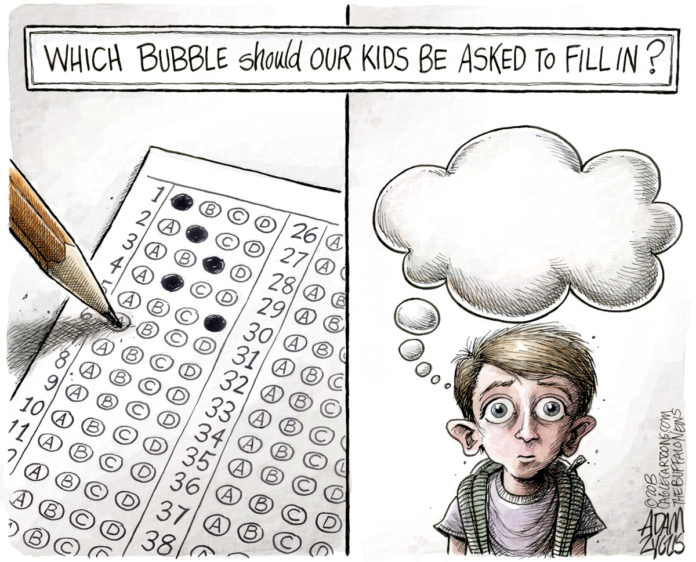BY JOHN THOMPSON
I live 90 miles from Tulsa. While I take a keen interest in Oklahoma school reform issues, I do not want to intrude into Tulsa Public Schools [TPS] business. Given all of the other recent progress by Oklahomans in moving beyond the scorched earth edu-politics of recent years, I was dismayed that the TPS would hire a Chief for Change, Deborah Gist, at a time when Oklahoma’s former Chief for Change, Janet Barresi, was leaving office. It will be up to Tulsans to determine their own school policies. So, I will merely offer some facts regarding the issues that patrons might want to consider.
When it was announced that Gist was the only remaining candidate in a closed-door process of selecting a new superintendent, it was claimed that the nationally respected NAEP data showed that Rhode Island schools had improved more under Gist than the national average. Moreover, it was implied that student performance growth for low-income children of color was greater in Rhode Island during Gist years.
These sorts of statements are known as “Mis-Naepery,” or the misuse of NAEP data.
Since Tulsa is an 80% low-income district, the key question is whether Gist addressed her state’s racial and economic achievement gaps. [After all, when claims of major gains in student performance are announced, usually they are found to be a result of economic and demographic shifts, so social scientists look at long-term patterns broken down by race and income.]
Even one of Gist’s closest allies, RI-Can, complained that 2013 NAEP data showed, “Most gaps between white and non-white and low-income and non-low-income remain unchanged or in some cases, have grown.” For instance, between 2011 and 2013, the gap separating reading proficiency between white and black 4th graders increased by 50%. They also cited, “The fourth-grade reading gap between low-income and non low-income students [which] grew from 29 points in 2011 to 36 points in 2013.”
The proper use of test score data for addressing that issue was analyzed in the most recent NAEP reports about 8th grade reading scores for black students: “This performance gap was not significantly different from that in 1998.” Placing 4th grade reading scores for black students in context, NAEP concluded: “This performance gap was not significantly different from that in 1992.” Placing 8th grade math scores for black students in context: “This performance gap was not significantly different from that in 1990.”
I could go on with these disappointing results, but the pattern is clear. There is no evidence that the expensive and divisive “reforms” implemented by Gist improved student performance. And claims regarding progress in increasing the graduation rate are equally questionable. Across the nation, since 2006, there has been a 1.3% per year increase in the graduation rate. These gains were propelled by a 15-point increase for Hispanic students and a 9-point increase for black students.
Moreover, the most likely explanation for the increase in the graduation rate is that they are due to “high touch” policies, such as investments in guidance counselors, not the test-driven methods embraced by Gist and other Chiefs for Change.
That brings us to one of the two most ill-conceived policies pioneered by Gist, the mass dismissal of teachers. The impetus for the failed School Improvement Grant [SIG] experiment and its Turnaround and Transformation policies was the Gates-funded “The Turnaround Challenge.” That solid synthesis of research noted that school turnarounds may require the removal of a small number of “culture-killing” teachers, who were not on board with the process. It explicitly warned against the mass removal of teachers, however. Teacher buy-in is essential, so the shortcut of removing large numbers of teachers would backfire, and it would be unlikely that qualified replacements could be found for those high-challenge schools.
Sure enough, across the nation, the investments of up to $5 million per school resulted in a decline in student performance in nearly one-third of them, and meager gains for most others. The most likely explanation is that the mass dismissal of veteran teachers, who often were guilty of nothing but holding the belief that test-driven reforms are wrong, resulted in Turnaround and Transformation schools staffed by inexperienced teachers.
“The Turnaround Challenge” also drew upon the best education research to explain why “instruction-driven, curriculum-driven” policies are “inherently incapable” of turning around schools with intense concentrations of children from generational poverty and trauma. This is crucial for two reasons.
First, the Gist and Chiefs for Change ideology is based on the questionable hypothesis that improved instruction within the four walls of the classroom can systemically overcome the legacies of extreme poverty.
Secondly, Gist and her fellow Chiefs pushed for charter school expansion. A few of their high-performing charters were successful, but they only admit and retain as many high-challenge students as they could handle. In other words, the Gist strategy has largely failed to improve the type of schools she will find in Tulsa.
To borrow from the great scholar, Professor Emeritus Larry Cuban, the doomed strategy of “deputizing” teachers as the agents to overcome poverty led to the other calamitous policy pushed by Gist and other Chiefs for Change. Before their theory was tested, Oklahoma and more than 40 other states were pressured into changing their law to include student test score growth in teacher evaluations. Even in 2009, a long string of scholarly organizations warned that these laws pushed the use of value-added models that are unreliable and invalid for evaluating individuals.
If they knew then what scholars have now documented, surely the Gates Foundation would not have gone down this value-added path.
When the Gates Foundation got around to studying the statistical models that it helped impose on our nation’s schools, it used a student sample that was only 56% low-income and that did not include nearly as many students on IEPs and English Language Learners as who attend Tulsa schools. Even so, the results of this costly experiment [even with its unrepresentative sample] were disappointing. Most likely, they would produce an exodus of top teachers from Tulsa to magnet and suburban schools where it is easier to raise test scores.
By now, it is clear that Cuban is correct and that value-added evaluations will go down in history as another failed quick fix and that they will be “like tissue-paper reforms of the past [e.g., zero-based budgeting, right- and left-brain teaching] that have been crumpled up and tossed away.”
I suspect that the key reason why Gist was considered for the superintendent’s position is that the Gates Foundation has invested heavily in Tulsa’s value-added teacher evaluation efforts. This is understandable. But Tulsans need to know the full story.
I have engaged in extensive communications with Gates scholars, and even the foundation’s vice president for research. These Gates-funded advocates are sincere. They admit to a number of mistakes. They acknowledge their lack of knowledge of the logistics of real schools when they developed their research methodologies. Often, they come close to publicly admitting that it was a mistake to rush their value-added experiment. Not surprisingly, they do not want it to fail.
But it is Tulsa patrons who should decide whether the salvaging of the Gates initiative should be a top priority for their district. Tulsans should consider the “stinging new report” from the Southern Regional Education Board on the value-added evaluations that were thrust on Oklahoma.
The SREB conducted focus groups in 58 Oklahoma school districts and found a “lack of buy-in and trust in the system.” It found “a remarkable portion of teachers and principals interviewed in focus groups” question the validity of Oklahoma’s standardized test data. There was even more distrust of the metrics for teachers of non-tested classes.
Tulsa, however, didn’t participate in the process.
The Tulsa World’s Andrea Eger, in Commission Hears Report Critical of Oklahoma’s Handling of Teacher Evaluations, reported that State Superintendent Joy Hofmeister “shares some of those concerns and questions.” As the SREB’s Andy Baxter explained, “If the theory is to help people get better in a rigorous way, people have to believe in it.” The quantitative portion, especially, is on course to “just blow up.”
Fortunately, Congress is about to pull the plug on the SIG grants that failed to turnaround schools, after inflicting so much damage on the teaching profession. Similarly, the federal mandates for value-added evaluations are likely to be scrapped. I would think that Tulsans would seek a way to move beyond these unfortunate experiments that prompted so much test, sort, and punish.
Regardless, the Tulsa patrons – not outsiders – should decide after full hearing of the evidence.
– Dr. John Thompson, an education writer whose essays appear regularly at The Huffington Post and in The Observer, currently is working on a book about his experiences teaching for two decades in the inner city of OKC. He has a doctorate from Rutgers University and is the author of Closing the Frontier: Radical Responses in Oklahoma Politics.









John- why did you say at the beginning that you don’t want to intrude into TPS business? This article directly contradicts that statement. Say what you mean.
Also- the Oklahoma State School Board Association (OSSBA) would be the authority on superintendent searches, correct? They do, after all, run many of the searches that districts conduct each year to replace retiring superintendents. Are their searches more “transparent” than the Tulsa search? Isn’t it a telling fact that OSSBA has commended TPS on the hiring of Dr Gist? It seems that all would be better served to work with TPS and Dr Gist in a collaborative fashion. Instead, this article reminds me of something that Dr Barresi would write in a false sense of “collaboration.”